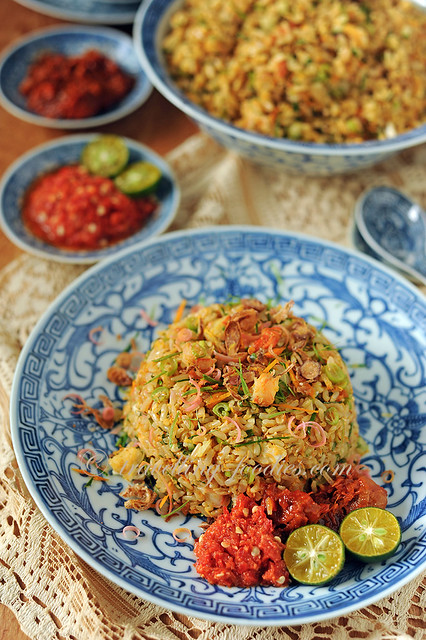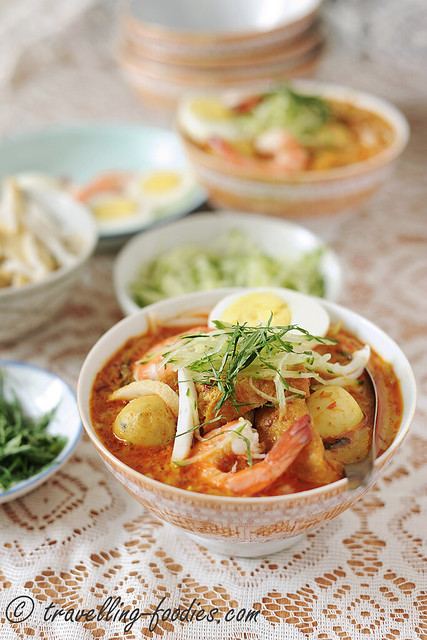On the Trail of a Phoenix – Nasi Ulam
Nasi Ulam, or pronounced as “nasik ulam” in Baba Malay is a classic Peranakan dish which has its roots in Southeast Asian cooking. Comprising of essentially a variety of chiffonaded herbs tossed in steamed fragrant rice, it is painstaking to prepare and thus usually served on “ari besair” during weddings, birthdays or other celebratory events.
Ondeh Ondeh: Buah Melaka: Klepon – A Revisit
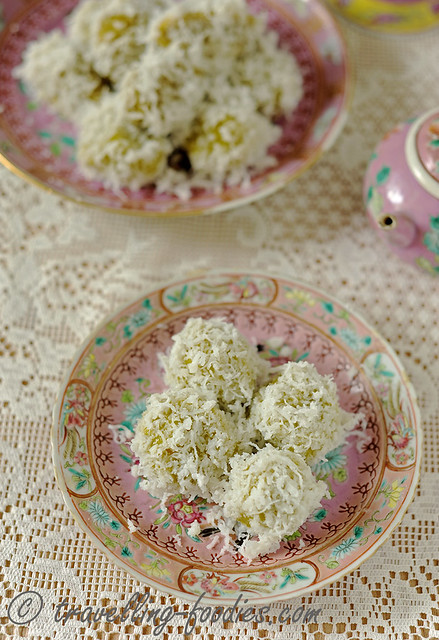
There are many kuehs which we grew up eating and enjoying, often not just because they taste good but also the other dimensions of the gastronomic experience that surpass that from just the palate that makes each bite memorable. Like lapis sagu or kueh lapis beras, which can be made more fun by peeling the kueh layer by layer, or in the case of ondeh ondeh, the sheer joy one receives as every one of these sticky and chewy balls explodes with each mouthful to unleash an avalanche of sweet and savory juices from within…
(more…)
Nyonya Taste Cuisine @ Melaka
There are many new restaurants and cafes springing up all over Melaka each showcasing their own interpretation of Melakan Peranakan cuisine. For me, that is a heartening thing as it allows us to sample more of how each dish may have slight nuances and variations when they are cooked by different folks. In my last trip to Melaka, I brought some of my friends to my friend Ruby Song’s restaurant, “Nyonya Taste Cuisine” located at the end of Kota Laksamana, just a stone’s throw away from the Jonker Walk shopping district. We were in for a treat!
On the Trail of the Phoenix – Pulot Inti

After a long hiatus from blogging, I’m finally getting my engine started again. So much has happened over just a blink of an eye. “Sekelip mata” we say in Baba patois, both good things and bad things. While I slowed down on blogging this period of time, I have not stopped cooking, baking or making kueh. In fact, I’d finally picked up the courage of taking orders and help people make kuehs and cook traditional Peranakan dishes for their friends and family to enjoy. It is a win win situation for me as well, as not only does this provide me with the opportunity to hone and sharpen my cooking and kueh making skills, it also helped to supplement the expenses of the cooking and baking hobby. Alas, I’m glad to be back on the blog again, with one of my favorite kuehs, Pulot Inti.
(more…)
On the Trail of the Phoenix -Revisiting Ayam Buah Keluak
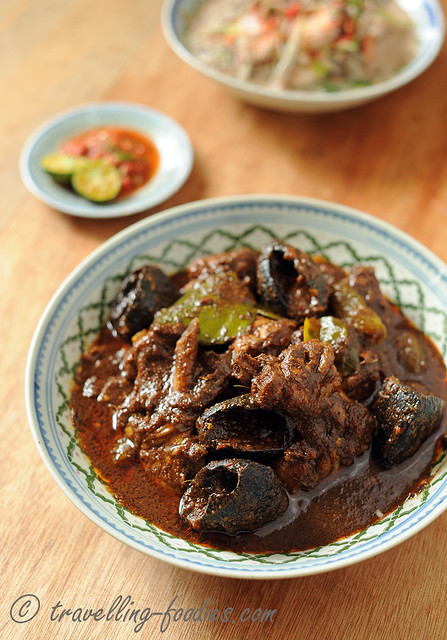
There are many dishes which one can immediately draw parallelism to Peranakan culture, signature dishes which form the core of what is understood by many as “Straits Chinese cuisine” today. Babi Pongteh, Sambal Jantong Pisang, Ikan Gerang Asam, Kuah Hee Pio or even simple day to day dishes like Telor Tempra and Pong Tauhu just to name a few. But the one true dish which is quintessentially Peranakan must surely be Ayam Buah Keluak. It is THE one dish which many have heard of, being curious about, tried before and perhaps can even relate to. I’d wrote about it twice on this blog, here and here, and also a masterclass I’d attended before out of curiosity, not to mention talk about it on countless occasions, so here is it again, a refresher discussion on this “ambassador dish” that bridges and opens the gateway for anyone who seeks a more in-depth understanding into the culture.
On the Trail of the Phoenix – Ikan Gerang Asam
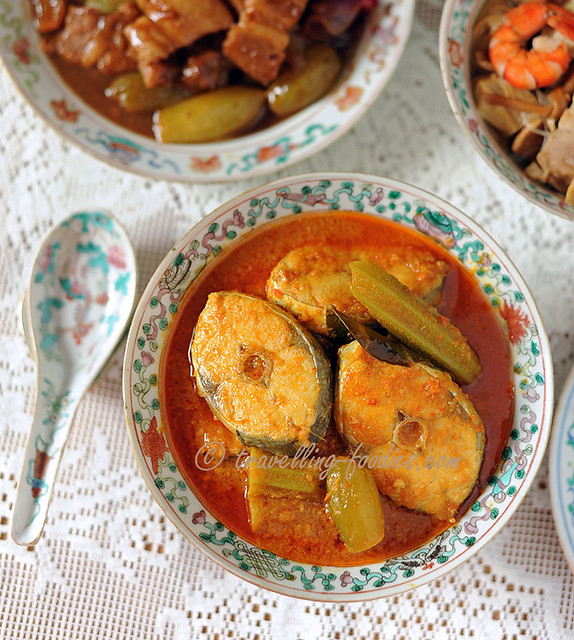
Ikan Gerang Asam is one of the first Peranakan dishes, or what is known to the babas and nyonyas as “laok embok” I’d “learnt” to cook when I was young, after getting to know the tricks to frying sunny sideups with runny yolks and crispy edges for telor tempra and braising tauyew bak until the collagen-packed babi sam cham become wobbly soft that is. “Cooking lessons” were never formal or formative, save for the times when I was taught how to use a “pisoh chye toh” , a Chinese cleaver that is, to do a wondrous list of things with it, to potong, to iris, to bukak, to persiang, to kupair a wide variety of ingredients. Otherwise it was always learning through observing how my mum and grandma worked around the kitchen while helping out with the tasks along the way and of course tasting the yummy dishes they’d prepared. And it was the same with “learning” to cook Ikan Gerang Asam”…
Pulot Panggang Sambal Lengkong
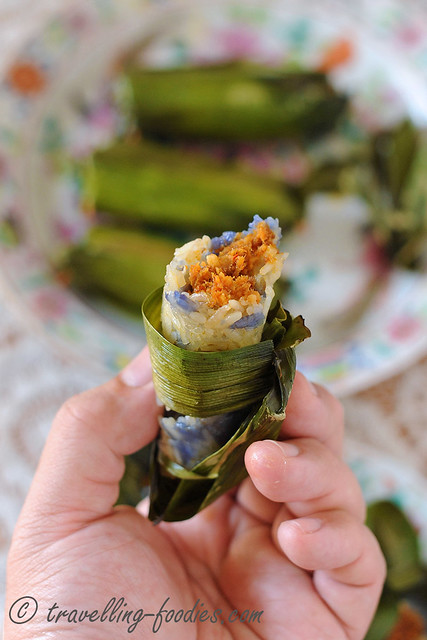
Don’t let your eyes deceive you. This is not the much coveted rempah udang, a Peranakan cuchi mulot which is a favorite amongst non-Peranakans as well. These are fashioned to look like rempah udang, the glutinous rice is coloured and cooked just like that in rempah udang, the wrapping is done exactly as how one would make rempah udang. So what is it that sets what you see in the photo apart from the real McCoy? Some of you would have guessed it by now, it is the filling…instead of using an “inti rempah udang“, I’d used a portion of the sambal lengkong I made just before Chinese New Year. It tastes vastly different from the inti used in rempah udang, but I assure you that it is no less delicious!
On the Trail of the Phoenix – Sambal Udang Belimbing
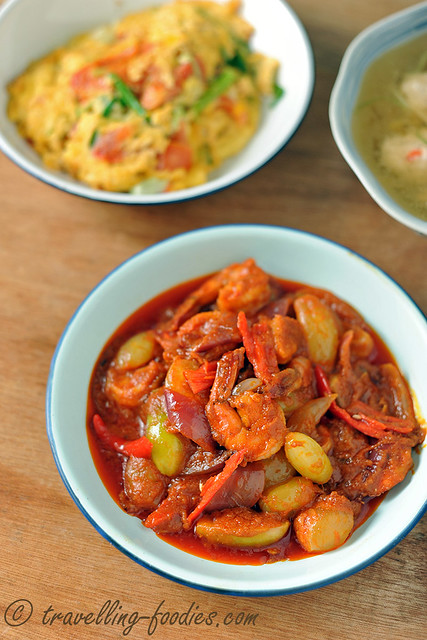
We enjoy homecooked food a lot. And because of that, we enjoy cooking at home a lot. What seemed to be a chore in the past, helping my mum wash the vegetables, cut the ingredients, tumbok the rempah in the past became what I missed the most now that mum is no longer with us. The dishes are usually very simple, spanning across a good range of Peranakan fare, not forgetting dishes from Chinese cuisine which she’d learnt from my grandmothers, our neighbours, her colleagues-turned friends at work, our old neighbours, and even from the vegetable sellers, fishmongers, butchers and hawkers from whom she will steal a recipe or cooking tip from. From them, she expanded her culinary repertoire that stretched across other cuisines to cook dishes from these dialectal groups when she didn’t even know how to speak those tongues! Amazing how fast and effortless it was for her to learn new dishes, sometimes indirectly from just tasting it once or twice would she be able to decode the recipe or figure out the cooking methods. Those were the days when experimentation was the fun thing to do and authenticity was never a question in mind.
(more…)
紅龜粿 Ang Ku Kueh & the Peranakan Kueh Koo Merah

For many of us, food is not just something we consume merely to sate our physical needs for survival. Extending far beyond that, food is what we enjoy with our loved ones, friends and family, as a vehicle to promote solidarity, camaraderie and togetherness. Food is what invokes and invigorates our senses, establishes a communal experience which evolves irrevocably into a shared memory, or an identity that eventually gets woven into a group’s rich history and cultural heritage. In short, food provides for many of us, a glimpse of our past and acts as an intangible extension into our future. Often times, such food are likely to be signature dishes unique to a cuisine or synonymous to a community. Yet food that possess such prowess and bestowed with such a mission isn’t necessarily elaborated or complicated. It is often the simplest things that leave a lifelong impression and sometimes, even an everlasting legacy.
Sambal Lengkong – Peranakan Spicy Fish Floss

For some folks, preparations for Chinese New year starts as early as a month back right after Tang Chek. It marks the beginning of spring cleaning as well as cooking and baking to usher the new year. Folks like give an assortment of kuehs and snacks to friends and family during this period of time. The all-time favorite would be kueh tair, i.e. Peranakan Pineapple Tarts, with kueh belanda and kueh bangket etc following closely behind. Another top on the list is acheir, the Peranakan achar and Sambal Lengkong too is given away as a token of appreciation as well for some.
(more…)
Kueh Tair – Making Peranakan Pineapple Tarts
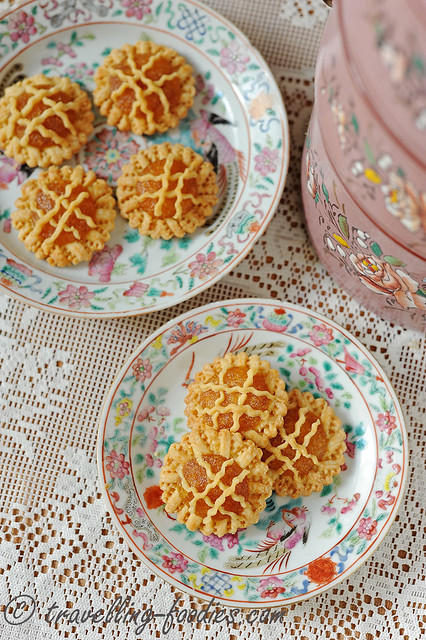
My Facebook updates these few days are crawling with feeds and photos of friends who are out and about with their CNY baking. The festive mood seems to have really kicked in with many friends busy with churning out CNY goodies from their kitchens, for “a thousand and one reasons” as I was joking with a friend, be it for friends and family to snack on and enjoy, to really get into the festive mood, to sell and earn some pocket money, to polish one’s pastry making skills and most importantly, because one simply feels like making! In other words, there really isn’t a need for a proper impedus that gets one going with all the CNY cooking and baking. Just follow your heart.
As with many, one of the absolute quintessential Chinese New Year “kueh” which we definitely must have on the table are the pineapple tarts. I bake it every year and this year, I’d decided to make the Peranakan pineapple tarts aka “kueh tair” which is slightly more elaborated than the standard ones we get outside. It is quite laborious but I’m glad I did it. Lots more room for improvement for sure and I thank my Peranakan friends who had taught me some of the “tricks to the trade” and also given me much support and encouragement along the way. So here is my first batch of “kueh tair” for 2016.
(more…)
Tiffin “Tok Panjang” Lunch @ Casa Del Rio Melaka

Yes! I am back in Melaka again, barely a month since the last trip, only because there is still so much of this city that awaits to be explored and discovered. Despite the numerous trips I have made here over recent years, there is always something interesting, new and bizarre or old and nostalgic that continues to beckon me for a return to this beautiful city.
The only difference this time round is I am not travelling up alone but together with 4 other foodie-minded friends to experience what Malacca has to offer. The first stop upon getting off the coach is a welcome “tiffin lunch” set in the style of a Tok Panjang at the luxurious and idyllic Casa del Rio Melaka.
On the Trail of the Phoenix – Chap Chye… A Revisit

Chap Chye is a quintessential dish for anyone who takes an interest in Peranakan food to learn to cook . It has its roots in Chinese cuisine of course but has since become deeply ingrained and naturalised into the Straits Chinese way of cooking. For us, Chap Chye is a dish which never fail to make its appearance on the dining table whenever we celebrate a major festival at my Grandma’s. Like I’d mentioned before, this dish together with kari ayam and ngoh hiang are hailed as the “holy trinity” which reminds me much of my grandma’s cooking even until today. It is her speciality, which she faithfully prepared the day before, in full knowing that the dish takes a good overnight rest for the flavours to develop and mature. Traditionally, chap chye is a must whenever there is ancestral prayers, alongside other dishes like pongteh but as the generations evolved, the rule for chap chye as a laok semayang has relaxed over time as it is now commonly enjoyed even over simple family dinners.
On the Trail of the Phoenix – Kueh Dadar Chelop Kuah Santan
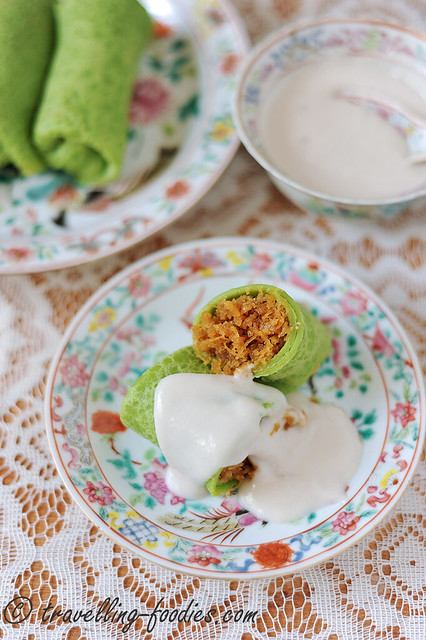
Kueh dadar is one of my favorite kueh, which we enjoyed tremendously as children as I’d mentioned in this post two years back. Known also as kuih ketayap, kuih gulung or kuih lenggang to some Malay communities, it is also a kueh which I revisit very often in my kitchen, sometimes eaten just on its own, or when I’m up for something more elaborated or wish for greater contrariety, a savory kuah santan would be quickly prepared using the leftover coconut milk from the batter to “chelop” the kueh dadar in. If the American kids grew up dunking Oreos in a glass of milk, kueh dadar chelop kuah santan must definitely be part of the wonderful childhood memories Peranakans have collectively.
Baba & Nyonya Heritage Museum – A Book Review
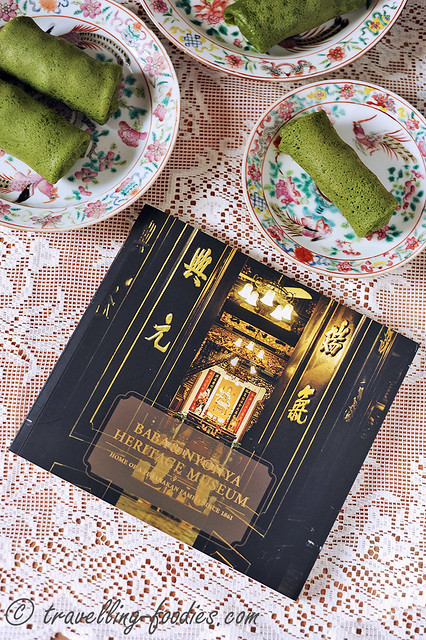
Literature and publications on the Peranakan community are far and few in between, so when a new book on this unique group to the Malay Archipelago becomes available, it is always met with much excitement and anticipation, and the new “Baba & Nyonya Heritage Museum – Home of a Peranakan Family since 1861” is no exception . Fresh and hot from the publishers just a couple of weeks back, many of us await gleefully for a glimpse and surely, it did not disappoint.
On the Trail of the Phoenix – Katong Laksa
Last weekend, Singapore celebrated her Golden Jubilee, 50 years of glorious nation building which saw her rose from a third world nation, separated from Malaysia and forcefully pushed onto her road of independence which she had not wished for, to become one of the major key players in the regional political and economic development. In fear that the Chinese-majority population in Singapore would threaten the rule and dilute the prowess of the Malay-dominant UMNO which controls the Federation of Malaya then, Tunku Abdul Rahman “talak” Singapore, ousting her from the Federation which she had joined less than two years back. Left largely on her own, the initial years were full of staggers and struggles, but through the sheer hardwork and determination of our parents, Singapore’s first taste of success is by no means an easy feat. While the dramatic transformation our island state undertaken had been repeatedly retold in media all over the world, like a fairytale, this Golden Jubilee marks only but the closure of the first chapter of her ongoing story, far from the climatic conclusion many seem to be perceiving and enjoying. Lying ahead are more challenges to follow, many of which are intangible and unpredictable. As the paradigm shift over the last 20 years or so deemed that our fate should become invariably intertwined with the increasingly turbulent global climate, it seems like our future no longer lies solely in our own hands. From the frustrating and stifling realities like escalating costs of living, increasing population densities beyond comfort limits, all-too-frequent MRT breakdowns, to other “softer dimensions” like the disintegration of our social fabric, attrition of our cultural bearings and extinction of our local heritage. The latter aspects seem lesser noticeable but far more important than how they are usually being played out for without our bearings and roots, we are nothing. On the whole, Singapore is a nation that grew so rapidly overnight, that she had hardly any time to reflect and ponder over what was sacrificed, eroded and forever lost. Too caught up with being and staying competitive, her people were tugged into the rat race, constantly instilled with invisible fears of the repercussions and possible aftermath for being left behind or simply not being Number One. In our concerted efforts as a nation to become richer in tangible gains like economic growth, integrated infrastructure, standards of living, global ranking, we had also become poorer, as we silently mourn for our loss, some deplorable beyond being reparable. Friends who visit Singapore seem to be always telling me how fast our country grows, some areas changed and developed beyond recognition in a matter of just a couple of years. Like a child who is all too eager to want to grow up and step into adulthood to prove her worth, much of her time is spent to better herself, with little left to enjoy her childhood and growing up years, let alone to smell the flowers along the way. As we admire the towering skyscrapers that grew like magical beanstalks, we also lament the demolishing of the old architecture built brick upon brick by our forebears. As we broaden our expressways to ease increasingly tense traffic conditions, we scramble to save our old cemeteries from being raised to the ground to make way for establishments in the name of modernisation and modernity. In short we live in an age of dilemma, torn between the want to constantly “majulah” and the need to stay in touch with our past. We see that happening all over Singapore, and even more so in our beloved Katong.
Luncheon with Baba Jolly Wee @ Concorde Hotel

In conjunction with the ongoing festivities and jubilation to celebrate our 50 years of nation building, Concorde Hotel Singapore located right in the heart of the Orchard Road shopping belt has specially chosen and recreated a selection of Peranakan dishes as part of the spread for the buffet available at their Spices Cafe. Two weeks ago, the hotel specially invited Baba Jolly Wee, together with some of his family members and close friends, for a luncheon organised as a tribute and appreciation for putting together some of the Peranakan staples on the menu and coaching the chefs who helm the kitchen at the Spices Cafe during his stint as their culinary consultant. Baba Jolly, a doyen of Straits Chinese cuisine in Singapore who is now well into his eighties, is held in great esteem and highly regarded here for his work on promoting baba-nonya culinary culture to fellow Singaporeans, as well as the rest of the world.
On the Trail of the Phoenix – Apom Balek Durian

Peranakan desserts and snacks are such a large and colourful collection of delectables that they warrant special attention on their own. Being a unique group with members from such different backgrounds and rich heritage, the sweet and savory treats which signify the Peranakan community are exemplary of this wonderful diversity. Look closely, and one would be able to identify easily the cultural elements from the origins of forebears where the Peranakan roots developed from. Just to name a few, we have Kueh Koo Merah and Popiah from the Chinese, Rempah Udang, Pulot Inti with Malay-Indonesian influences, Pang Susi and Kueh Blanda with Portuguese-Dutch origins and of course Roti Babi from the proximal colonial links, and these are only a teeny tip of the iceberg of the repertoire affectionately known as “Kueh Chuchi Mulot” to the babas and nyonyas.
Many of these kuehs apart from tasting really good, are symbolic with their cultural significance tightly woven into the customs and practices of the Peranakan tapestry of life in the yesteryears. Some are prepared specially for specific occasions, like kueh bakol for the Chinese New Year, and were enshrouded with much mysticism through a relay of “patangs” (taboos) which had to be observed to strict accordance for guaranteed success in their making. Some like kueh koo itam were made almost exclusively for ancestral worship and serving them during other joyous or celebratory events would only invite “koosmangat!” from the nyonyas with their overtly animated and dramatised “terpranjat” look, not forgetting a string of gossips that would soon follow and before long the extended family or even the whole community would know who “kentot“. Many of these kuehs, like kueh koo, kueh sarlat (gading galoh), kueh lapis beras (kueh genggang) are “colour coded”, so it mattered to many Peranakans “what” to serve “when”, to “whom” and in “which colour”. Like many of the earlier mentioned kuehs with specific “functions”, apom balek is no exception.
On the Trail of the Phoenix – Kueh Sarlat Durian
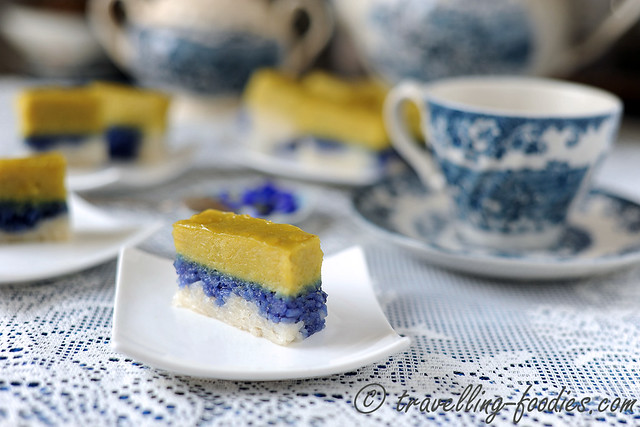
“What is a chuchi mulot?” , a common question I get from friends who see me use the phrase over and over again on Facebook, especially recently with all the desserts like “Sago Gula Malacca“, “Pengat Pisang” and “Bika Ambon” I’d been making. “Chuchi mulot” is the way “cuci mulut” is written in Baba Malay,with the latter term to literally mean “mouthwash” in standard Bahasa Melayu. This is probably the equivalent of the western concept of a “palate cleanser” in haute cuisine, though chuchi mulots are customarily served at the end of a meal, or as a tea-time snack on their own.
What constitutes a good chuchi mulot then? For me, it has to have several things. Firstly, it must bear contrast to the dishes served earlier in the meal, both in texture and flavour, often the now-sweetness against the then-savory, or the cooling to soothe and tame the earlier spice and heat. Secondly, the components in a chuchi mulot, ideally should also show distinctive variance amongst one another, being multi-dimensional, flavours layered, each building upon the other. Yet despite the seeming differentiation, the chuchi mulot should remain concerted as a harmonious conglomeration, bringing the meal to a resounding finale. Seemingly difficult to achieve, there are many a chuchi mulots within the vast repertoire of Peranakan desserts and kuehs that do precisely as I’d described, when carefully executed and finely made that is. Kueh Sarlat is one such fine example. And as if it is not exciting and enriching enough as it is, Kueh Sarlat Durian, with the twist of the much-loved tropical fruit incorporated, takes it up a notch and brings the chuchi mulot to the next level.
(more…)
On the Trail of the Phoenix – Sago Gula Melaka
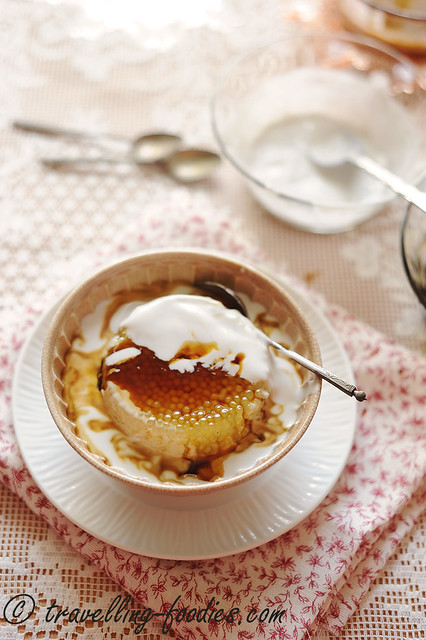
The weather has been somewhat erratic and unforgiving of late, tormentous heat wave for the last 2 weeks or so making the days go by in an utmost unbearable manner and then came the torrential rain yesterday afternoon. Despite the downpour, the cool-down it provided was only short-lived and temporal as it is back to another stuffy and hazy day. In need of something cold and refreshing, I made another favorite Peranakan chuchi mulot of mine for some instant relief. Looks like I’m on a dessert making spree! Sago Gula Melaka is incredulously easy to prepare and can be made way ahead. Just barely 30 min of work last night before going to bed and I’m ready to indulge in all that santan and gula melaka goodness this afternoon!
(more…)
On the Trail of the Phoenix – Pengat Pisang

Peranakan cuisine is well-known for its assortment of kuehs and sweet dishes, otherwise known as “chuchi mulot“. Most appropriately known as “palate cleansers” as many of these desserts, packed with much of their rich and sugary goodness break the monotony of the earlier main course dishes which are already imbued with much piquant flavours in spicy, savory and tang. The balance they provide brings about much contrast to the earlier dishes in a meal, and at the same time adding more experiential dimension and depth to the overall palate sensation, not to mention a resounding conclusion to an often hearty meal.
Bubor Cha Cha, Chendol and Pulot Itam, just to name a few, are some of the favorite chuchi mulots around, but my absolute “to cook the soonest and enjoy the fastest” so as to to curb that sweet tooth craving, has to be Pengat Pisang.
(more…)
On the Trail of the Phoenix – Telor Tempra

Those who know me well will know that I am an advocate of Peranakan home-cooking being approachable and simple, unlike what is typically heard and said about Straits Chinese cooking being laborious and tedious. While there are indeed dishes in the Baba Nyonya cuisine which are more painstaking to prepare, there is a repertoire of Peranakan dishes which require little time to cook and even less time to enjoy as they are so delicious, they are gobbled down in no time!
When I run out of ideas for what to prepare for a simple dinner, the ” tempra” sauce is my to-go-to style of Peranakan cooking which could be used with a wide variety of ingredients, all delicious and simple to prepare. No rempah to pound, no long hours of stewing, it usually manifest as “ikan tempra” or “ayam tempra” in our household but when I want something really fast and furiously done, “telor tempra” is most definitely the dish I would whip up as it requires just a bare few minutes from the chopping board to the dining table.
On the Trail of the Phoenix – Apom Balek Nyonya
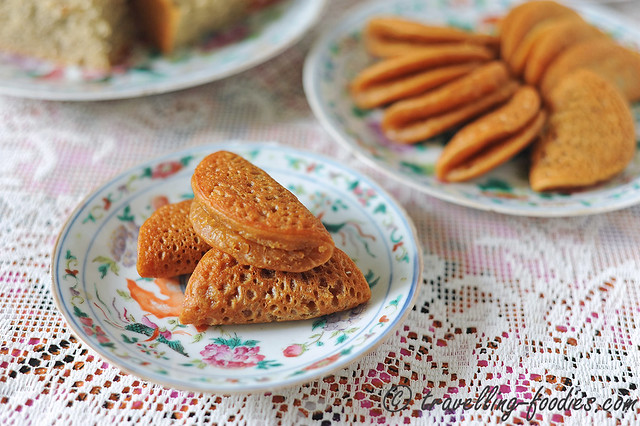
A short post to document an experiment as I was trying out a recipe for the Peranakan version of “apom balek“. Unlike the crispy and thin “apam balik” we typically see at the Malay food stalls in pasar malams, or the thick Chinese version called “min chiang kueh” we eat for breakfast, this version favoured by the Peranakans in Malacca and Singapore are much smaller and more dainty. Despite using the same mould, I don’t make apom balek as often as I do for apom berkuah, simply because I very much prefer the latter, especially with the irresistible kuah pengat pisang to go along. Nonetheless, I feel I do need to practice making this kueh which is important in many aspects of the Peranakan culture. So on goes with the experiment!
(more…)
